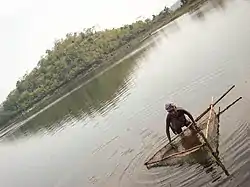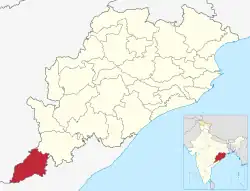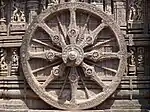Malkangiri district
Malkangiri district is the southwesternmost district in the Indian state of Odisha. It has two Vidhan sabha constituencies.
Malkangiri district | |
|---|---|
 | |
 Location in Odisha | |
| Coordinates: 18.25°N 82.13°E | |
| Country | |
| State | |
| Headquarters | Malkangiri |
| Government | |
| • Collector & District Magistrate | Vishal Singh, IAS |
| • Superintendent of Police | Nitesh Wadhwani, IPS |
| Area | |
| • Total | 5,791 km2 (2,236 sq mi) |
| Elevation | 195 m (640 ft) |
| Population (2011) | |
| • Total | 613,192 |
| • Density | 83/km2 (210/sq mi) |
| Languages | |
| • Official | Odia |
| • Other Local Language | Koya, Kuvi, Gutob |
| Time zone | UTC+5:30 (IST) |
| PIN | 764 xxx |
| Vehicle registration | OD-30 |
| Sex ratio | 1.004 ♂/♀ |
| Literacy | 49.49%[1] |
| Lok Sabha constituency | Nabarangpur(ST) |
| Vidhan Sabha constituency | 2
|
| Climate | Aw (Köppen) |
| Precipitation | 1,700 millimetres (67 in) |
| Avg. summer temperature | 47 °C (117 °F) |
| Avg. winter temperature | 13 °C (55 °F) |
| Website | malkangiri |
| This article is part of a series on |
| Odisha |
|---|
 |
| Governance |
|
| Topics |
|
Districts Divisions |
| GI Products |
|
|
History
Local legend claims Valmiki wrote the Ramayana on the banks of the Tamasa river. The region was known as Malyavantagiri in the Ramayana, and it was believed Sitakunda was the bathing-place of Sita, near Mudulipada. Local legend claims the Pandavas spent a year in exile in the dense forests of Malkangiri. Kanamraju, Balaraju and Poturaju are the three famous Lords of this area, who are being worshiped by the people. On every alternative year, Badayatra, the festival of these Lords is celebrated throughout the district.
Prior to 1936, Malkangiri was a part of Koraput district of the Madras Presidency. In 1936, Koraput District was merged into Odisha and Malkangiri Tahasil was included in Koraput District. This Tahasil was a part of Nawarangpur sub-division of Koraput District. On 1 January 1962, Malkangiri subdivision was carved out. In 1958, refugees from East Pakistan were settled in the area in the Dandakaranya Project. This project continued for 30 years until it was declared closed in the year 1988.
Finally on 2 October 1992, Malkangiri was carved out of Koraput District. Today, the district has become known as a hotbed for Maoist activities.[2]
Administrative setup
There are 07 Blocks and 07 Tahasils under one Sub-Division in Malkangiri district are listed in the following table.
| # | 07 Blocks | 07 Tahasils |
|---|---|---|
| 1 | Malkangiri | Malkangiri |
| 2 | Mathili | Mathili |
| 3 | Khairput | Khairput |
| 4 | Chitrakonda | Chitrakonda |
| 5 | Korukonda | Kudumulgumma |
| 6 | Kalimela | Kalimela |
| 7 | Podia | Motu |
There are 12 Police Stations under two Police Sub-Divisions in Malkangiri district are listed in the following table.
| Malkangiri Police Sub-Division | Chitrakonda Police Sub-Division | |
|---|---|---|
| 1 | Malkangiri P.S. | Chitrakonda P.S. |
| 2 | Mathili P.S. | Mudulipada P.S. |
| 3 | Podia P.S. | Orkel P.S. |
| 4 | Kalimela P.S. | Jodamba P.S. |
| 5 | M.V. 79 P.S. | Papermetla P.S. |
| 6 | Motu P.S. | |
| 7 | Energy P.S., Malkangiri |
Economy
In 2006 the Ministry of Panchayati Raj named Malkangiri one of the country's 250 most backward districts (out of a total of 640).[3] It is one of the 19 districts in Odisha currently receiving funds from the Backward Regions Grant Fund Programme (BRGF).[3]
Demographics
| Year | Pop. | ±% p.a. |
|---|---|---|
| 1901 | 58,275 | — |
| 1911 | 70,059 | +1.86% |
| 1921 | 67,874 | −0.32% |
| 1931 | 80,047 | +1.66% |
| 1941 | 94,894 | +1.72% |
| 1951 | 106,637 | +1.17% |
| 1961 | 141,955 | +2.90% |
| 1971 | 268,865 | +6.60% |
| 1981 | 335,169 | +2.23% |
| 1991 | 422,326 | +2.34% |
| 2001 | 504,198 | +1.79% |
| 2011 | 613,192 | +1.98% |
| source:[4] | ||
According to the 2011 census Malkangiri district has a population of 613,192,[6] roughly equal to the nation of Solomon Islands[7] or the US state of Vermont.[8] This gives it a ranking of 523rd in India (out of a total of 640).[6] The district has a population density of 106 inhabitants per square kilometre (270/sq mi).[6] Its population growth rate over the decade 2001-2011 was 21.53%.[6] Malkangiri has a sex ratio of 1016 females for every 1000 males,[6] and a literacy rate of 49.49%.[6] 8.08% of the population lives in urban areas. Scheduled Castes and Scheduled Tribes make up 22.55% and 57.83% of the population respectively.
At the time of the 2011 Census of India, 34.06% of the population in the district spoke Odia, 23.40% Koya, 21.48% Bengali, 4.18% Desia, 2.97% Telugu, 2.59% Kuvi, 1.99% Bhuiyan, 1.72% Proja and 1.36% Halbi as their first language.[9] There are several other languages spoken in the district including Remo and Gta', this last language spoken by the Didayi people. The Bengali language is spoken mostly by descendants of refugees from Bangladesh erst while East Pakistan. The Odia Language is the dominant language with its dialects Desia and Paraja.
Politics
Vidhan sabha constituencies
Malkangiri has 2 Vidhan Sabha constituencies, electing members to the Odisha Legislative Assembly:[10][11][12][13]
| No. | Constituency | Reservation | Extent of the Assembly Constituency (Blocks) | Member of 14th Assembly | Party |
|---|---|---|---|---|---|
| 146 | Malkangiri | ST | Malkangiri (NAC), Kalimela, Malkangiri, Podia, Korukunda (part) | Aditya Madhi | BJP |
| 147 | Chitrakonda | ST | Balimela (NAC), Mathili, Kudumulugumma, Khairaput, Korukonda (part) | Purna Chandra Baka | BJD |
References
- "Sundargarh District Portal : District at a Glance". Archived from the original on 21 May 2017. Retrieved 22 February 2016.
- "History | District Malkangiri, Government Of Odisha | India". Retrieved 30 August 2020.
- Ministry of Panchayati Raj (8 September 2009). "A Note on the Backward Regions Grant Fund Programme" (PDF). National Institute of Rural Development. Archived from the original (PDF) on 5 April 2012. Retrieved 27 September 2011.
- Decadal Variation In Population Since 1901
- "Table C-01 Population by Religious Community: Odisha". Census of India, 2011. Registrar General and Census Commissioner of India.
- "District Census Handbook 2011 - Malkangiri" (PDF). Census of India. Registrar General and Census Commissioner of India.
- US Directorate of Intelligence. "Country Comparison:Population". Archived from the original on 13 June 2007. Retrieved 1 October 2011.
Solomon Islands 571,890 July 2011 est.
- "2010 Resident Population Data". U. S. Census Bureau. Archived from the original on 28 October 2011. Retrieved 30 September 2011.
Vermont 625,741
- "Table C-16 Population by Mother Tongue: Odisha". Census of India 2011. Registrar General and Census Commissioner of India.
- Assembly Constituencies and their EXtent
- Seats of Odisha
- "List of Member in Fourteenth Assembly". ws.ori.nic.in. Archived from the original on 2 May 2007. Retrieved 19 February 2013.
Member Name
- "Odisha Legislative Assembly". odishaassembly.nic.in. Retrieved 2 July 2020.




